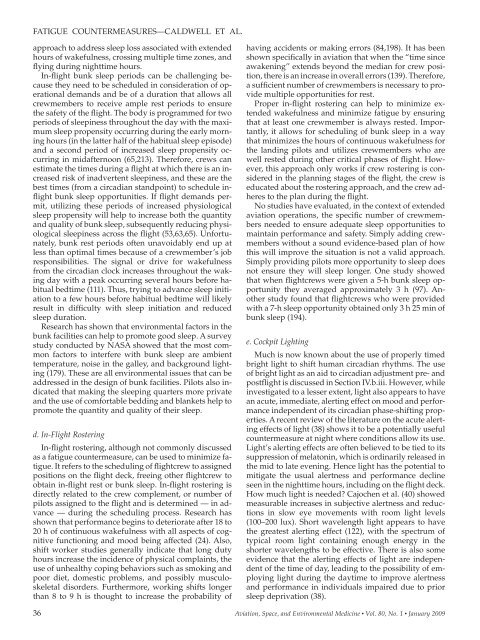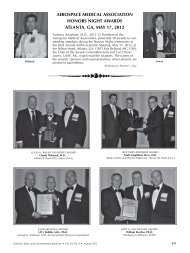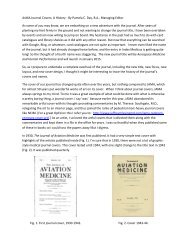Fatigue Countermeasures in Aviation - Aerospace Medical Association
Fatigue Countermeasures in Aviation - Aerospace Medical Association
Fatigue Countermeasures in Aviation - Aerospace Medical Association
You also want an ePaper? Increase the reach of your titles
YUMPU automatically turns print PDFs into web optimized ePapers that Google loves.
FATIGUE COUNTERMEASURES — CALDWELL ET AL.<br />
approach to address sleep loss associated with extended<br />
hours of wakefulness, cross<strong>in</strong>g multiple time zones, and<br />
fly<strong>in</strong>g dur<strong>in</strong>g nighttime hours.<br />
In-flight bunk sleep periods can be challeng<strong>in</strong>g because<br />
they need to be scheduled <strong>in</strong> consideration of operational<br />
demands and be of a duration that allows all<br />
crewmembers to receive ample rest periods to ensure<br />
the safety of the flight. The body is programmed for two<br />
periods of sleep<strong>in</strong>ess throughout the day with the maximum<br />
sleep propensity occurr<strong>in</strong>g dur<strong>in</strong>g the early morn<strong>in</strong>g<br />
hours (<strong>in</strong> the latter half of the habitual sleep episode)<br />
and a second period of <strong>in</strong>creased sleep propensity occurr<strong>in</strong>g<br />
<strong>in</strong> midafternoon ( 65 , 213 ). Therefore, crews can<br />
estimate the times dur<strong>in</strong>g a flight at which there is an <strong>in</strong>creased<br />
risk of <strong>in</strong>advertent sleep<strong>in</strong>ess, and these are the<br />
best times (from a circadian standpo<strong>in</strong>t) to schedule <strong>in</strong>flight<br />
bunk sleep opportunities. If flight demands permit,<br />
utiliz<strong>in</strong>g these periods of <strong>in</strong>creased physiological<br />
sleep propensity will help to <strong>in</strong>crease both the quantity<br />
and quality of bunk sleep, subsequently reduc<strong>in</strong>g physiological<br />
sleep<strong>in</strong>ess across the flight ( 53 , 63 , 65 ). Unfortunately,<br />
bunk rest periods often unavoidably end up at<br />
less than optimal times because of a crewmember’s job<br />
responsibilities. The signal or drive for wakefulness<br />
from the circadian clock <strong>in</strong>creases throughout the wak<strong>in</strong>g<br />
day with a peak occurr<strong>in</strong>g several hours before habitual<br />
bedtime ( 111 ). Thus, try<strong>in</strong>g to advance sleep <strong>in</strong>itiation<br />
to a few hours before habitual bedtime will likely<br />
result <strong>in</strong> difficulty with sleep <strong>in</strong>itiation and reduced<br />
sleep duration.<br />
Research has shown that environmental factors <strong>in</strong> the<br />
bunk facilities can help to promote good sleep. A survey<br />
study conducted by NASA showed that the most common<br />
factors to <strong>in</strong>terfere with bunk sleep are ambient<br />
temperature, noise <strong>in</strong> the galley, and background light<strong>in</strong>g<br />
( 179 ). These are all environmental issues that can be<br />
addressed <strong>in</strong> the design of bunk facilities. Pilots also <strong>in</strong>dicated<br />
that mak<strong>in</strong>g the sleep<strong>in</strong>g quarters more private<br />
and the use of comfortable bedd<strong>in</strong>g and blankets help to<br />
promote the quantity and quality of their sleep.<br />
d. In-Flight Roster<strong>in</strong>g<br />
In-flight roster<strong>in</strong>g, although not commonly discussed<br />
as a fatigue countermeasure, can be used to m<strong>in</strong>imize fatigue.<br />
It refers to the schedul<strong>in</strong>g of flightcrew to assigned<br />
positions on the flight deck, free<strong>in</strong>g other flightcrew to<br />
obta<strong>in</strong> <strong>in</strong>-flight rest or bunk sleep. In-flight roster<strong>in</strong>g is<br />
directly related to the crew complement, or number of<br />
pilots assigned to the flight and is determ<strong>in</strong>ed — <strong>in</strong> advance<br />
— dur<strong>in</strong>g the schedul<strong>in</strong>g process. Research has<br />
shown that performance beg<strong>in</strong>s to deteriorate after 18 to<br />
20 h of cont<strong>in</strong>uous wakefulness with all aspects of cognitive<br />
function<strong>in</strong>g and mood be<strong>in</strong>g affected ( 24 ). Also,<br />
shift worker studies generally <strong>in</strong>dicate that long duty<br />
hours <strong>in</strong>crease the <strong>in</strong>cidence of physical compla<strong>in</strong>ts, the<br />
use of unhealthy cop<strong>in</strong>g behaviors such as smok<strong>in</strong>g and<br />
poor diet, domestic problems, and possibly musculoskeletal<br />
disorders. Furthermore, work<strong>in</strong>g shifts longer<br />
than 8 to 9 h is thought to <strong>in</strong>crease the probability of<br />
hav<strong>in</strong>g accidents or mak<strong>in</strong>g errors ( 84 , 198 ). It has been<br />
shown specifically <strong>in</strong> aviation that when the “ time s<strong>in</strong>ce<br />
awaken<strong>in</strong>g ” extends beyond the median for crew position,<br />
there is an <strong>in</strong>crease <strong>in</strong> overall errors ( 139 ). Therefore,<br />
a sufficient number of crewmembers is necessary to provide<br />
multiple opportunities for rest.<br />
Proper <strong>in</strong>-flight roster<strong>in</strong>g can help to m<strong>in</strong>imize extended<br />
wakefulness and m<strong>in</strong>imize fatigue by ensur<strong>in</strong>g<br />
that at least one crewmember is always rested. Importantly,<br />
it allows for schedul<strong>in</strong>g of bunk sleep <strong>in</strong> a way<br />
that m<strong>in</strong>imizes the hours of cont<strong>in</strong>uous wakefulness for<br />
the land<strong>in</strong>g pilots and utilizes crewmembers who are<br />
well rested dur<strong>in</strong>g other critical phases of flight. However,<br />
this approach only works if crew roster<strong>in</strong>g is considered<br />
<strong>in</strong> the plann<strong>in</strong>g stages of the flight, the crew is<br />
educated about the roster<strong>in</strong>g approach, and the crew adheres<br />
to the plan dur<strong>in</strong>g the flight.<br />
No studies have evaluated, <strong>in</strong> the context of extended<br />
aviation operations, the specific number of crewmembers<br />
needed to ensure adequate sleep opportunities to<br />
ma<strong>in</strong>ta<strong>in</strong> performance and safety. Simply add<strong>in</strong>g crewmembers<br />
without a sound evidence-based plan of how<br />
this will improve the situation is not a valid approach.<br />
Simply provid<strong>in</strong>g pilots more opportunity to sleep does<br />
not ensure they will sleep longer. One study showed<br />
that when flightcrews were given a 5-h bunk sleep opportunity<br />
they averaged approximately 3 h ( 97 ). Another<br />
study found that flightcrews who were provided<br />
with a 7-h sleep opportunity obta<strong>in</strong>ed only 3 h 25 m<strong>in</strong> of<br />
bunk sleep ( 194 ).<br />
e. Cockpit Light<strong>in</strong>g<br />
Much is now known about the use of properly timed<br />
bright light to shift human circadian rhythms. The use<br />
of bright light as an aid to circadian adjustment pre- and<br />
postflight is discussed <strong>in</strong> Section IV.b.iii. However, while<br />
<strong>in</strong>vestigated to a lesser extent, light also appears to have<br />
an acute, immediate, alert<strong>in</strong>g effect on mood and performance<br />
<strong>in</strong>dependent of its circadian phase-shift<strong>in</strong>g properties.<br />
A recent review of the literature on the acute alert<strong>in</strong>g<br />
effects of light ( 38 ) shows it to be a potentially useful<br />
countermeasure at night where conditions allow its use.<br />
Light’s alert<strong>in</strong>g effects are often believed to be tied to its<br />
suppression of melaton<strong>in</strong>, which is ord<strong>in</strong>arily released <strong>in</strong><br />
the mid to late even<strong>in</strong>g. Hence light has the potential to<br />
mitigate the usual alertness and performance decl<strong>in</strong>e<br />
seen <strong>in</strong> the nighttime hours, <strong>in</strong>clud<strong>in</strong>g on the flight deck.<br />
How much light is needed Cajochen et al. ( 40 ) showed<br />
measurable <strong>in</strong>creases <strong>in</strong> subjective alertness and reductions<br />
<strong>in</strong> slow eye movements with room light levels<br />
(100– 200 lux). Short wavelength light appears to have<br />
the greatest alert<strong>in</strong>g effect ( 122 ), with the spectrum of<br />
typical room light conta<strong>in</strong><strong>in</strong>g enough energy <strong>in</strong> the<br />
shorter wavelengths to be effective. There is also some<br />
evidence that the alert<strong>in</strong>g effects of light are <strong>in</strong>dependent<br />
of the time of day, lead<strong>in</strong>g to the possibility of employ<strong>in</strong>g<br />
light dur<strong>in</strong>g the daytime to improve alertness<br />
and performance <strong>in</strong> <strong>in</strong>dividuals impaired due to prior<br />
sleep deprivation ( 38 ).<br />
36 <strong>Aviation</strong>, Space, and Environmental Medic<strong>in</strong>e x Vol. 80, No. 1 x January 2009





